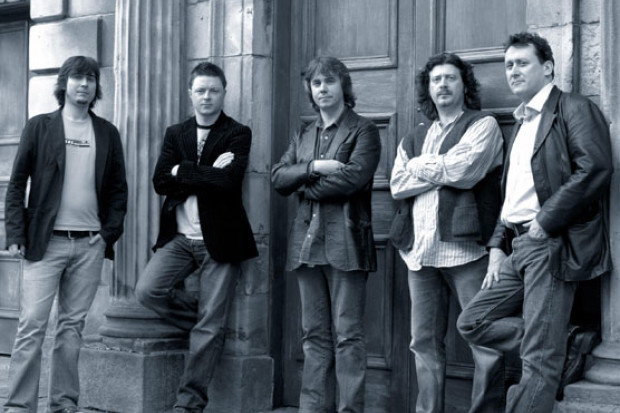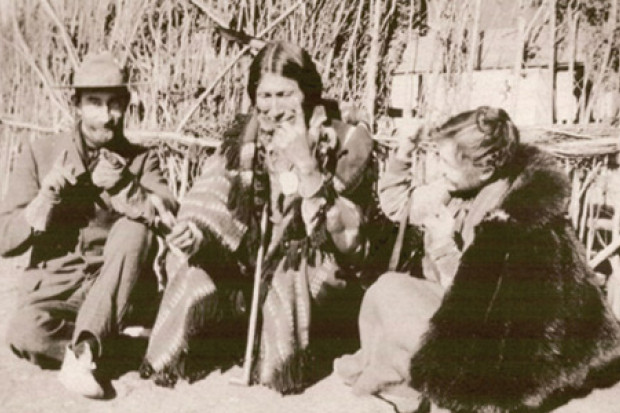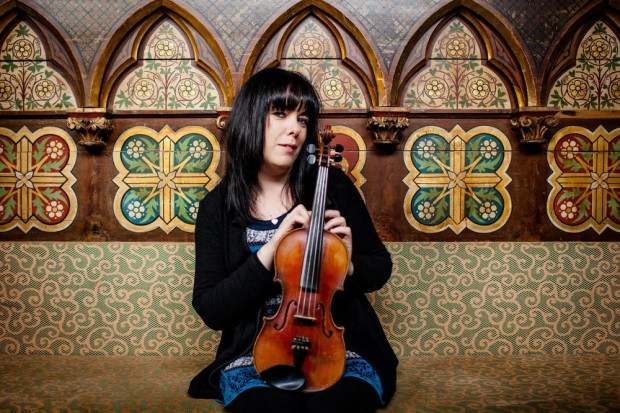Music at hi-res
A vantage point is a very special thing. From deep in the thick of something it is sometimes difficult to appreciate how that ‘something’ appears to those outside it. When I first listened to Notes from the Heart (Cló Iar-Chonnachta) by Mick, Louise & Michelle Mulcahy and Buílle (Vertical Records) by Niall and Caoimhín Vallely and Paul Meehan the most immediate impression was the huge difference between them – almost as if they were two different forms of music. Depending on your viewpoint, of course, they are, or not. I imagine that to someone unacquainted with the forms and conventions of Irish traditional music they would sound alike, but isn’t that the problem with music today – no-one really listens to unfamiliar genres closely enough to distinguish the fine grain?
The piper Pat Mitchell has a favourite way of getting people to realise what they don’t know about Irish dance music. He has two reproductions of an illuminated page from the Book of Kells – one at a high and one at a low resolution. In the latter, much of the fine detail is lost; in the former it can be seen. The point is that from a distance of a few yards they look the same. It’s only when you approach and examine them that you can appreciate the level(s) of detail and complexity in the true reproduction. This is analogous to traditional music played in authentic style, and that provided by modern pastiche merchants – from the street outside they might sound alike, but the former rewards attentive listening with layers of interest which are not to be found in the latter.
Notes from the Heart consists of ‘old’ tunes, albeit some with known composers. The notes to the tunes reveal that they come from a great number of sources – for the seventeen tracks on the CD nearly fifty musicians are acknowledged – and the information on the tunes alone fills nine pages of the sixteen-page booklet. Buílle, on the other hand, consists almost entirely of new music. The CD insert consists of a single folded sheet, and the background of the tunes is dealt with in twelve lines – mostly brief indications of the circumstances of their composition. These are made to the traditional template, to be sure, and could in the future enter the tradition, but at the moment they are new tunes.
The experience of critically listening to these two recordings together led me to see something that I hadn’t realised before. I discovered that I was applying different sets of criteria to the music. The fact that the music on Buílle is presented so simply, almost without context, is as it should be. There is as yet nothing to say about these tunes as to their place in tradition. But is that, in fact, the way we actually apprehend traditional music – by forming a judgement as to how it ‘fits’ in the tradition, with no consideration of the purely musical aspects of the material? I’m beginning to think that it is, and that we unconsciously abdicate our musical judgment to ‘tradition’ in the form of the celebrated ‘folk process’.
Perhaps that is a reasonable thing to do. The crucible of popular appraisal is usually capable of burning off most dross, so that the items that pass through it unscathed or even (usually) improved are, by definition, items that will appeal to popular taste. In this case popular taste means the collective taste of those who effectively determine what gets played and, so, transmitted, i.e. the musicians themselves. If a tune has survived this process it is obviously, then, a good tune.
So, while listening to Notes from the Heart I found I was appraising the music in this way, measuring the tunes and performance against my knowledge of past practice and against what I know of the vast corpus of Irish music. When listening to Buílle I did not have the same yardsticks. In fact I began to wonder why this CD wasn’t handed for review to someone who reviews ‘new’ or ‘contemporary’ music. But that raises other questions, doesn’t it? The devotees of ‘modern music’ are handicapped by tunnel vision to the same degree as any other group, despite their intimations of musical broadmindedness. I can’t imagine the music on Buílle being considered worth their notice, failing as it does to conform to their notions of what ‘modern composers’ should be producing. Mind you, I might have got them wrong; I can only judge by what I read in the pages of JMI!
This being said, what about the recordings? Well they are alike in one respect – each of them reveals the superb musical skills and sensibilities of the respective performers. Notes from the Heart comprises sufficient variety in the instrumentation that it could be used on its own for a radio show, and there would be no complaints of monotony. The implements deployed by the three musicians include the uilleann pipes (a wonderful-sounding set in C by Geoff Wooff), fiddle, concertina, harp, piano, flute, accordions in four different pitches and a melodeon. More texture is added by the presence on some tracks of Cyril O’Donoghue on bouzouki or guitar, or Tommy Hayes on bodhrán. These resources are combined in different ways to provide a varied succession of well-played pieces.
Highlights for me were the occasions when the pipes were in use (usually combined with tuned-down fiddle), and also the delicious cold bath (this is a compliment!) of the solo melodeon track. Coming after the lusher sounds of the ensemble playing it provides a welcome refresher for the palate, which is not at all to suggest that it would seem less accomplished out of this context. The Mulcahys have skill to burn, and taste and appreciation to direct it. Track two includes the song-tune ‘An Seanduine Dóite’ played as a jig. As I listened to it, before I had read the notes, I formed the firm impression that they could only have learned the tune from a singer. I was gratified, and impressed, to find that this was indeed the case, Séamus Begley being their source. It is no small feat to preserve the phrasing and inflection of a singer while losing nothing of the rhythm required of a jig. One could dance to this and enjoy the song at the same time.
Disappointments for me lay in the breakdown of the material. Of the seventeen tracks nine consist of sets of reels, and five of sets of jigs. This leaves room for two sets of flings and one set of slides. This is possibly reflective of common modern practice – the monoculture of wall-to-wall reel sessions, with no space or tolerance for other components of the tradition – but hardly a considered choice! No hornpipes, barn-dances, set-dances, slip jigs or polkas, not to mention the more exotic fauna! Not a single air or harp piece, let alone a song! Also, I felt that the solo harp track did not work as well as the remainder of the music. The vitality of the tunes seemed to have been subdued by the requirements of harp technique. Just because one can play ‘The Bucks of Oranmore’ on the harp doesn’t mean that one should. Does the world need a mannered ‘Bucks’? Seems like a contradiction in terms! A minor annoyance is the absence from the individual track notes of any indication of the musical line-ups for the tracks. These cavils aside it is a very fine and enjoyable recording, and a credit to the publishers, Cló Iar-Chonnachta, who go from strength to strength.
As indicated above, Buílle is a completely different kettle of fish. The first track, ‘The Wrong House’, roars in on a wave of jazz-flavoured playing, suggesting that Niall Vallely, around whose extraordinarily dextrous concertina playing and original compositions the CD is constructed, plans to take no prisoners. Things settle down however with subsequent tracks. Tracks 2 and 3, ‘Grappa Groove’ and ‘Farewell To McCarthy’s’, consist of tunes in 6/8 rhythm, the first at dance pace, the second slower. In playing the first tune of track 2 Vallely uses a heavily accented off-beat rhythm for one passage of a few bars. It is a feature never heard among traditional players and reminds me of the sort of gimmick favoured by newcomers to the music, whose heads are already stocked with musical ideas from pop and rock music. If you wanted you could hear examples any night of the week in any pub in Temple Bar in Dublin. I think it somewhat spoils what is a good tune, but maybe that’s the dancer in me. Track 4 is ‘The Singing Stream Air’, an excerpt from the suite for four uilleann pipes composed by Niall Vallely and published in full on the Armagh Pipers’ Club’s excellent recording Live Recordings from the William Kennedy Piping Festival (WKPFCD001). This is a lovely piece of work, a gorgeous air. I detect a trace of the song-air ‘Dónal Óg’ in one or two bars, but it’s not uncommon for different airs to share the odd gene or two, and anyway, you couldn’t breed from better stock than ‘Dónal Óg’. Vallely’s air stands on its own feet however and is a piece that will be added to many repertoires in the coming years.
Throughout the recording one is struck by Vallely’s astonishing virtuosity on the concertina, but also by his musical imagination and inventiveness. One senses that he is not constrained by any limits, either of ability or vision, apart from the self-imposed one of creating within the broad context of Irish traditional music. He can exploit the possibilities of all tune-types and present pieces which are nominally in the same rhythm but have a totally different feel to them. He even nods in the direction of the exotic with a piece in 11/8 time. This made me think more of Dave Brubeck than Bill Whelan, and that’s also a compliment.
His music is provided with very capable support from Paul Meehan on guitar and Caoimhín Vallely on piano, with further support on bodhrán from Brian Morrissey. I dislike accompaniment on principle. I don’t see that the music needs it and its usual function, to my mind, is to provide a crutch for those not musically literate enough to appreciate the rhythm of a dance tune. That said, there’s accompaniment and accompaniment, and the playing here is generally sensitive and supportive. On one tune – the second tune on track two – the backing grates on my ears. The insistent ‘dum-deh dum-deh’ beat obscures rather than supports the 6/8 rhythm and all the magic that Vallely injects into it, and attracts the focus to itself and away from the tune. Exactly what accompaniment shouldn’t do!
As indicated earlier, this is new music, not traditional music, although it may become that too. It is a recording that one listens to purely for its music, free of context or connotation.
Published on 1 July 2006
Terry Moylan is a researcher and archivist with Na Píobairí Uilleann. He is the author of The Age of Revolution in the Irish Song Tradition 1776-1815.














